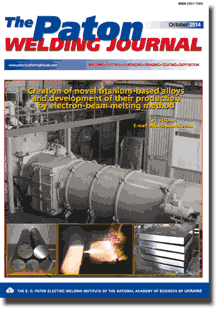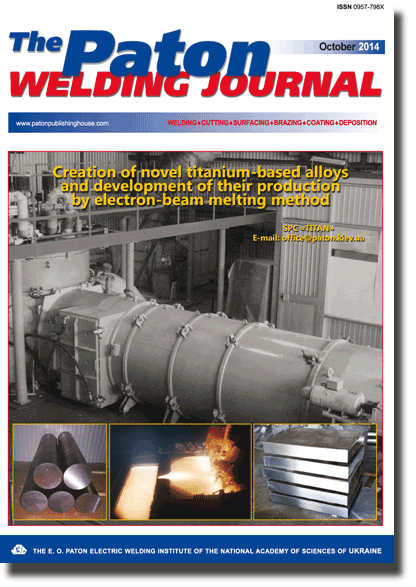| 2014 №10 (01) |
DOI of Article 10.15407/tpwj2014.10.02 |
2014 №10 (03) |

The Paton Welding Journal, 2014, #10, 11-14 pages
INFLUENCE OF NON-UNIFORMITY OF HEATING ON UPSETTING FORCE VALUE AND FORGING TIME IN FLASH-BUTT WELDING OF FLAT RING
A.V. MOLTASOV, S.M. SAMOTRYASOV, V.V. KNYSH, P.N. CHVERTKO and K.V. GUSHCHIN
E.O. Paton Electric Welding Institute, NASU. 11 Bozhenko Str., 03680, Kiev, Ukraine. E-mail: office@paton.kiev.uaAbstract
One of the reasons of occurrence of stresses and displacements in the rings, manufactured by flash-butt welding (FBW), is the non-uniform temperature field, which is formed as a result of electric current shunting. In the frames of the present work the temperatures in different characteristic spots at the final stage of fulfillment of FBW of steel ring in machine K724 were measured. Measurements showed that at the investigated stage of welding process the temperatures of controlled spots are little changed with time, i.e. quasi-stationary heat flow takes place. Function of temperatures was preset in the form of Fourier series around the circumferential coordinate, moreover as a result of symmetry the odd members of this series were not taken into account. It appeared sufficient to be restricted by four first terms of the series. Change of temperatures in radial direction, determined from the conditions of stationarity of heat flow, showed that the action of temperature field in the ring hinders approaching of edges being welded. It results in the fact that a part of upsetting force is consumed for overcoming the elasticity forces caused by non-uniformity of heating. For the steel 20 ring considered the upsetting force, required for formation of joint, increased by 16.5 %. Besides, the presence of temperature stresses increases the force striving to rupture a butt after welding, thus leading to the necessity to prolong the butt forging time by 4 s. 7Ref., 4Figures.
Keywords: flash-butt welding, flat rings, temperature field, stationary heat flow, temperature stresses, upsetting force, forging time
Received: 24.03.14
Published: 28.10.14
References
1. Kuchuk-Yatsenko, S.I., Chvertko, P.N., Semyonov, L.A. et al. (2013) Flash butt welding of products of high-strength alloys based on aluminium. The Paton Welding J., 7, 2-6.
2. Kochergin, K.A. (1952) Selection of technology of resistance welding. Leningrad: Sudpromgiz.
3. Carslow, Ch.S., Eger, D. (1964) Heat conductivity of solids. Moscow: Nauka.
4. Boley, B., Weiner, J. (1964) Theory of thermal stresses. Ed. by E.I. Grigolyuk. Moscow: Mir.
5. Timoshenko, S.P. (1937) Theory of elasticity. Leningrad; Moscow: ONTI.
6. Timoshenko, S.P., Goodier, J.N. (1975) Theory of elasticity. Moscow: Mir.
7. Chvertko, P.N., Moltasov, A.V., Samotryasov, S.M. (2014) Calculation of upsetting force in flash butt welding of closed-shape products. The Paton Welding J., 1, 46-50. https://doi.org/10.15407/tpwj2014.01.07
Suggested Citation
A.V. Moltasov, S.M. Samotryasov, V.V. Knysh, P.N. Chvertko and K.V. Gushchin (2014) Influence of non-uniformity of heating on upsetting force value and forging time in flash-butt welding of flat ring. The Paton Welding J., 10, 11-14.The cost of subscription/purchase order journals or individual articles
| Journal/Currency | Annual Set | 1 issue printed |
1 issue |
one article |
| TPWJ/USD | 384 $ | 32 $ | 26 $ | 13 $ |
| TPWJ/EUR | 348 € | 29 € | 24 € | 12 € |
| TPWJ/UAH | 7200 UAH | 600 UAH | 600 UAH | 280 UAH |
| AS/UAH | 1800 UAH | 300 UAH | 300 UAH | 150 UAH |
| AS/USD | 192 $ | 32 $ | 26 $ | 13 $ |
| AS/EUR | 180 € | 30 € | 25 € | 12 € |
| SEM/UAH | 1200 UAH | 300 UAH | 300 UAH | 150 UAH |
| SEM/USD | 128 $ | 32 $ | 26 $ | 13 $ |
| SEM/EUR | 120 € | 30 € | 25 € | 12 € |
| TDNK/UAH | 1200 UAH | 300 UAH | 300 UAH | 150 UAH |
| TDNK/USD | 128 $ | 32 $ | 26 $ | 13 $ |
| TDNK/EUR | 120 € | 30 € | 25 € | 15 € |
AS = «Automatic Welding» - 6 issues per year;
TPWJ = «PATON WELDING JOURNAL» - 12 issues per year;
SEM = «Electrometallurgy Today» - 4 issues per year;
TDNK = «Technical Diagnostics and Non-Destructive Testing» - 4 issues per year.


